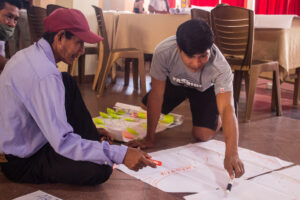
Matsés Advance Critical New Initiative for Indigenous Empowerment and Self-Governance
Indigenous groups the world over have historically been dispossessed of their ancestral territories, exterminated, or cheated for the extraction of their natural resources. Once missionaries established first peaceful contact with the Matsés in 1969, timber and petroleum interests quickly followed. In the turbulent years following sustained contact agents of timber companies took advantage of the Matsés communities by tricking them into cutting down high value timber species such as Spanish cedar and mahogany without any compensation. Petroleum companies carried out surveys and drilled exploratory wells deep into Matsés ancestral territory.
This exploitation has continued to present day. Outsiders exploit the Matsés limited formal education, language barriers, lack of understanding of accounting and legal systems, lack of external resources, as well as their fragmented leadership and social cohesion post-contact. Additionally, the Matsés struggle to receive legally entitled services and support from the government due to their remote location and blatant governmental corruption. These factors have left the Matsés chronically vulnerable to opportunistic predators, including narcotraffickers, international and local NGOs who receive funding for phantom projects that do not exist, corrupt politicians and bureaucrats, and carbon-cowboys intent on lifting their carbon rights.
In February 2019, Acaté leadership and the Matsés governing body (Junta Directiva) met and agreed that following the completion of the Matsés Indigenous Mapping Initiative, our next major collaboration would be to address the very heart of the challenges that underpin the Matsés internal struggles and enable external threats. The Matsés Indigenous Leadership and Governance project is a critically important initiative. The benefits, developed through this project and realized by the participants and the wider communities include: 1) the ability to obtain benefits from government agencies and NGOs by avoiding pitfalls through navigating the bureaucracies, 2) the ability to participate in the national economy, and 3) the ability to protect their territory from extractive industry including oil and timber companies encroaching on their territory. Most importantly, the project will contribute to the capacity and resiliency of the Matsés in maintaining unity against the external forces that threaten to degrade their unique way of life.
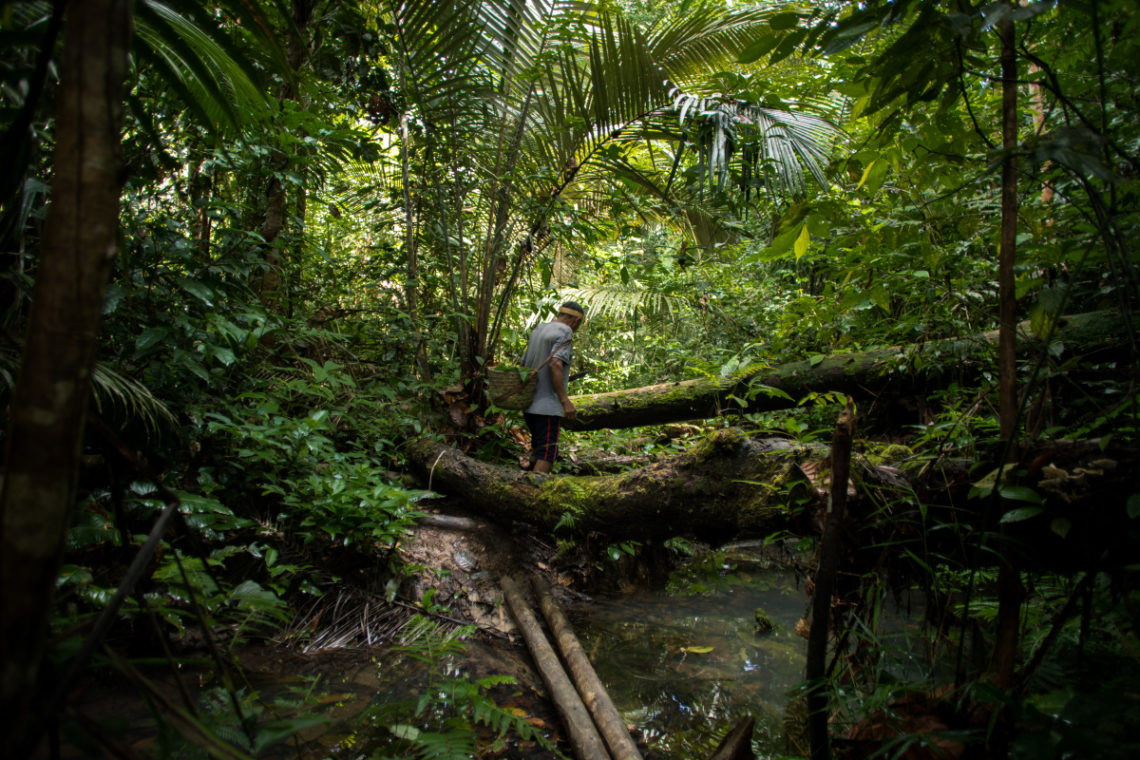
As a result of the Matsés Indigenous Leadership and Governance Initiative to date, the Matsés have translated their community bylaws into the Matsés language and explained key Peruvian government regulations and documents to all their leaders and communities. Matsés have enhanced their ability to interface and access government agencies, thereby improving their services. During the process, the Matsés uncovered massive irregularities in government funding earmarked for their district that was never received. This is now under investigation by the Peruvian anti-corruption authorities.
Prior to the start of the project, most Matsés had never even opened up a computer, let alone have the proficiency in use of computers and software that is so critical for their success in governance and their interactions with the outside world. To date, the Matsés Indigenous Leadership and Governance Initiative has resulted in the training of over 140 Matsés in computer literacy as well as the set-up and equipping of the first computer lab in Matsés territory.
Further, the Matsés have developed a written Plan of Life (Plan de Vida) to guide their implementation of their vision and aspirations for their communities and protection of their ancestral territories for years to come. The Matsés applied for and received United Nations recognition of the Matses Ancestral Territory as an indigenous and community conserved area (ICCA), the first such designation for an indigenous community in Peru.

Background
The Matsés, also known as Mayoruna, live along the Javari River and its tributaries in the remote region straddling the border of northeast Peru and Brazil. The Matsés historically avoided navigable rivers and maintained hostile relations with neighboring non-tribal Peruvians and Brazilians until 1969, when the Summer Institute of Linguistics missionaries contacted them. Since the late 1990s, acculturation of the Matsés to the national cultures has proceeded rapidly. Although most Matsés today meet all their nutritional needs through traditional subsistence activities including hunting, fishing, trapping, swidden horticulture, and collection of wild foods, their interactions and dependencies on the outside world are increasing rapidly.
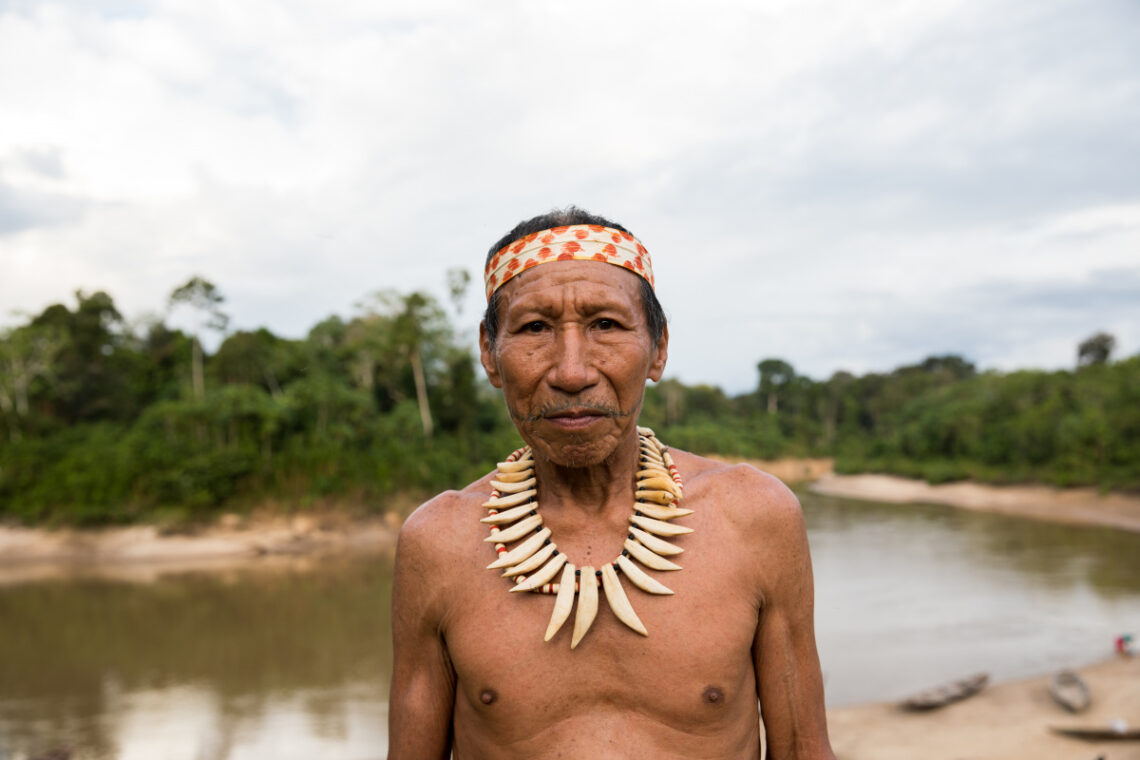
Nestor Bina, a Matsés who lives in the community of Puerto Alegre on the Rio Yaquerana, was an adult in 1969, when sustained contact with the outside world was initiated. As in the case with many indigenous groups, there are deep generational divides among the Matsés. The younger Matsés, who face racism and discrimination in dealings with the outside world, increasingly dissociate themselves from their identity as Matsés whereas the elders retain deep pride in their culture.
Traditionally, in the time prior to sustained contact, the Matsés lived in longhouses in large family groups. They had no formal governance, with decisions made through community consensus guided by the wisdom of respected elders. Following sustained peaceful contact with the Peruvian national culture, leadership structures were constructed in Matsés society based on Peruvian political structures. The requirement for Spanish speakers in leadership positions biased selection to primarily younger Matsés in leadership roles in order to facilitate communication with non-Matsés speakers in regional and national government. This had the effect of excluding many experienced and recognized elder Matsés community leaders from participating in the political decision making process and in official representation of their people to the outside world.
Elected Matsés leaders receive no formal training before starting office to prepare them for the enormous challenges they face. These Matsés leaders, with limited formal education, given no training or even an orientation class on assuming office, and supported with few external resources are left unaided to negotiate with well-funded timber companies, oil companies, NGOs, local government, regional government, national government, Department of Education, Department of Health, Department of Agriculture, Department of Culture, National Bank, adventure tourists, and even wildlife smugglers. These various organizations have their own agendas, and regrettably, not all are working in the best interests of the Matsés people or the rainforest the Matsés protect. The consequences have been profound for Matsés education, health, food security, and territorial integrity.
The specific aims of the Matsés Indigenous Leadership and Governance Initiative include the following goals:
1) To train Matsés participants and future leaders with knowledge of Peruvian laws and regulations
2) To provide training in accounting, regulatory compliance, and communication for good governance
3) To build their intrinsic governance and communication capacity across the communities
4) To capacitate Matsés participants and future leaders with computer literacy skills
5) To implement an innovative leadership training program for Matsés women’s empowerment
This initiative is designed to progress in four stages, three of which have been completed as of the writing of this field report.
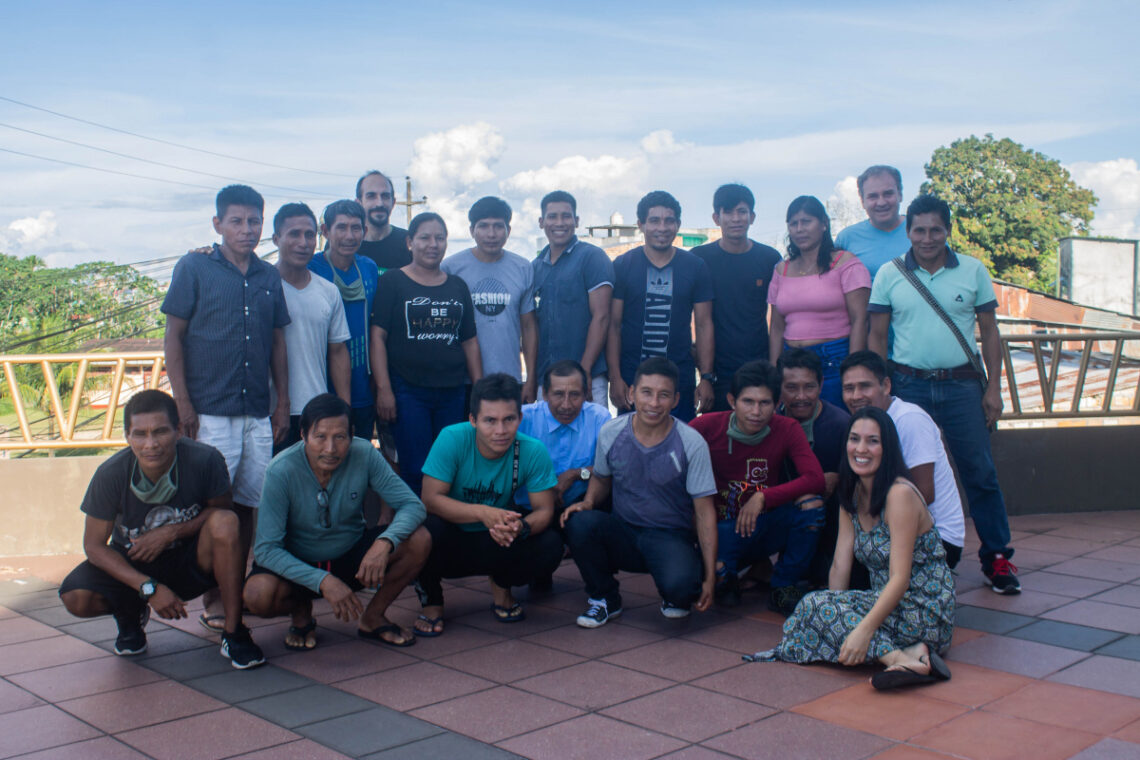
The Matsés Junta Directiva, Matsés chiefs from all fifteen communities, and Acaté personnel came together for the inaugural Matsés Leadership and Goverance workshop held in Iquitos for ten days in August 2020.
Stage 1: Planning Workshop, Leadership Training, Translation of Matsés Bylaws, Meetings with Government Agencies
The Matsés territory is vast. It can take four days to travel from one upriver community to the most distant community on a different river. There is no phone service in Matsés territory and not all the villages have working radios. These communication issues are compounded by the expense of holding meetings. Matsés leaders are neither allocated funds by the Peruvian state to organize large community meetings nor support for food and travel costs. This lack of governance infrastructure is exploited by organizations with their own agendas to create agreements with Matsés individuals but without community wide engagement and consent.
One of the most egregious examples was the “Carbon Cowboy” incident in 2011. This was a scheme to get the Matsés to sign over their carbon rights. The modus operandi utilized by the unscrupulous actors involved in this scam was to pay one or more elected Matsés leaders to sign their documents. In the case of the Carbon Cowboy, these signed documents were written in English. The scheme failed. The Matsés who received the payments ended up moving away from their territory in disgrace, and no carbon projects were ever developed.
Although Western use of the term “tribe” may connote a sense of unity in a people, the reality is that many indigenous groups emerge from the turbulence of contact with the outside world fiercely divided. Although many organizations would be extremely cautious about the optics and irregularities of perceived corruption in dealings with elected officials at home in the United States or Europe, it does not hold them back from sending direct payments to elected Matsés leaders to advance their agendas in a setting where there is less direct accountability. These organizations show little regard for the internal conflicts that inevitably erupt as the Matsés community discovers the payments and the conflicts of interest.
The totality of scams that have victimized the Matsés is tragically too extensive to go into a full accounting here but span fraudulent NGOs, oil companies, construction companies, carbon schemes, timber operators, tour companies, and government agencies. In this context the opportunity for the Matsés governing body and all the village chiefs to come together in Iquitos for ten straight days of meetings and training with no agenda other than to build their governance capacity was essential.
Recognition of Matsés Ancestral Territory as an Indigenous Protected Area
The first sessions of the meeting were to get the Matsés Ancestral Territory registered with the United Nations as an internationally recognized indigenous protected area or ICCA. The Matsés Ancestral Territory comprises an area of 3.7 million acres in Peru and contains among the most intact, biodiverse and carbon-rich forests in the world. Their communities safeguard and shield some of the last remaining uncontacted tribes living in isolation from unwanted encroachment by the outside world. With climate change and the accelerated rates of deforestation in the Amazon Basin, this vast area of intact primary forest that generations of Matsés have fought to protect is of vital importance for their future and is of global significance.
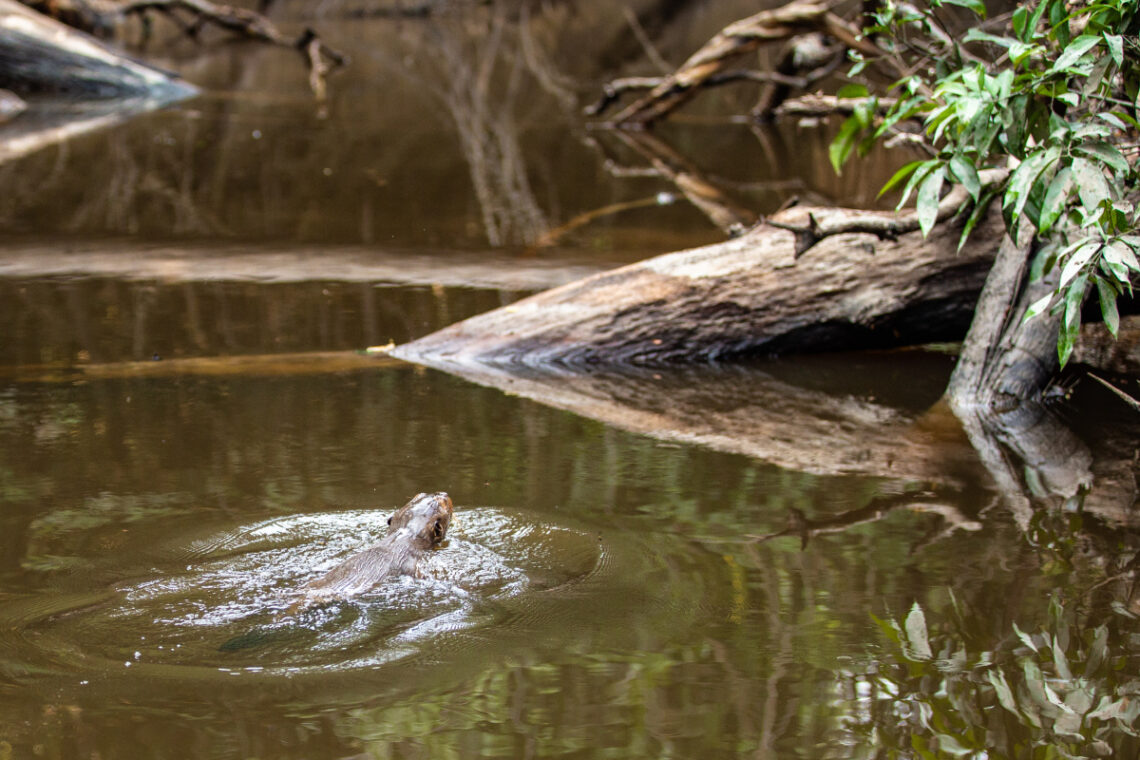
The requirements and process were explained to the Matsés leaders by SERVINDI (Servicios en comunicación Intercultural), the communications partner of the United Nations Small Grants Program in Peru. Fortunately the documentation that usually takes years to accomplish, had already been done by the Matses in conjunction with prior initiatives with Acaté, including mapping their territory, documenting their culture, and most importantly protecting their forests. With a large team working on all the necessary documentation, including a Plan of Life, we generated, organized, and submitted the proposal to the United Nations Environment Programme including the maps, ethnoecological books, and descriptions of the traditional medicine program. The registry was completed and can be seen here.
Matsés COVID-19 Relief Effort
The next order of business was to present Acaté’s Matsés COVID-19 Relief effort. After decades of phantom projects with other NGOs, false claims of association with the Matsés, and no reporting nor transparency for the Matsés, the Matsés are rightly suspicious about projects and wanted to understand our COVID-19 relief effort that we led in collaboration with several partners including Peruvian Ministry of Culture, Peruvian Ministry of Health, Xapiri Ground, Amazon Watch as well as the support of private donors. This was a great opportunity to present the basics of accounting and transparency using a real- life example of great interest to the leaders. The amounts and sources of the funding along with the receipts were presented. Then we created a report with the accounting, receipts, and photos of the effort with Matsés language explanations. The Matsés can now use this as a template for reporting to their constituents.
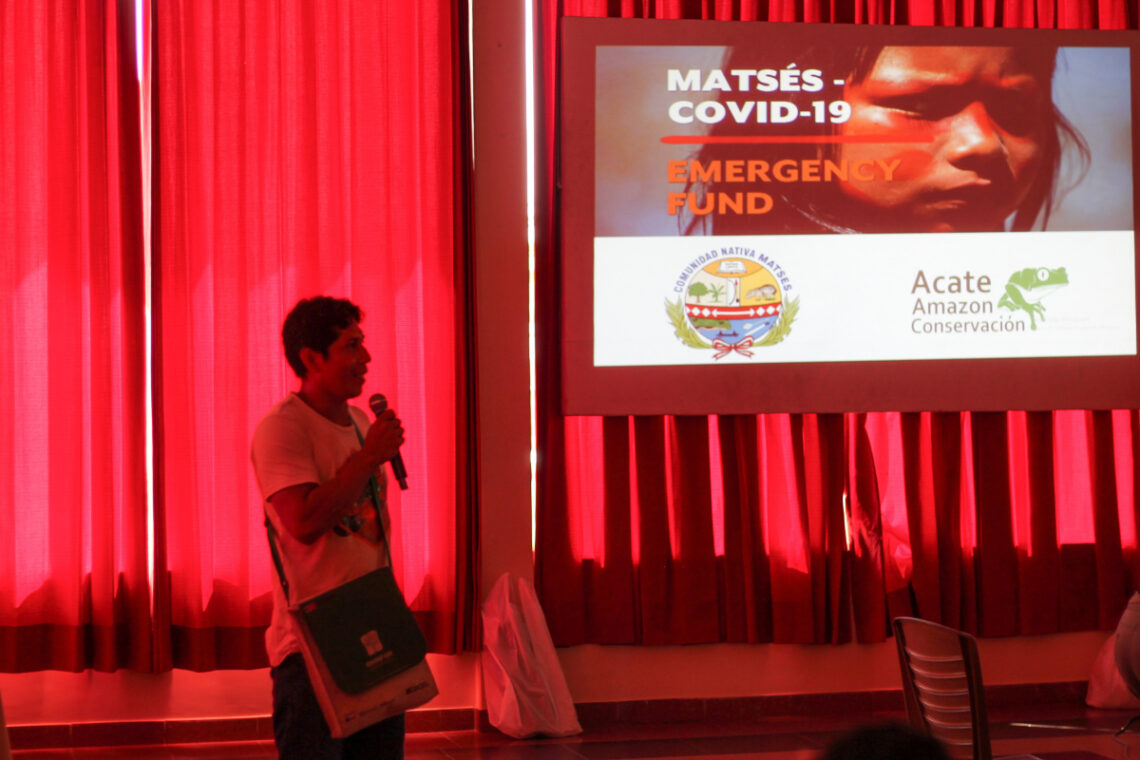
Matsés Chief Daniel Vela presents to assembled leaders the Matsés COVID-19 relief project, its development, funding sources and expenses, and outcomes. The emergency relief efforts during the COVID-19 pandemic was reported in our July 2020 Field Report.
Navigating Governmental Agencies
For the next day’s session, we invited the Loreto Ministry of Culture to give a presentation on the relevant departments of the Peruvian government and their functions and responsibilities. This provided a basis for the Matsés to navigate difficult bureaucratic hurdles by knowing which agency is responsible.
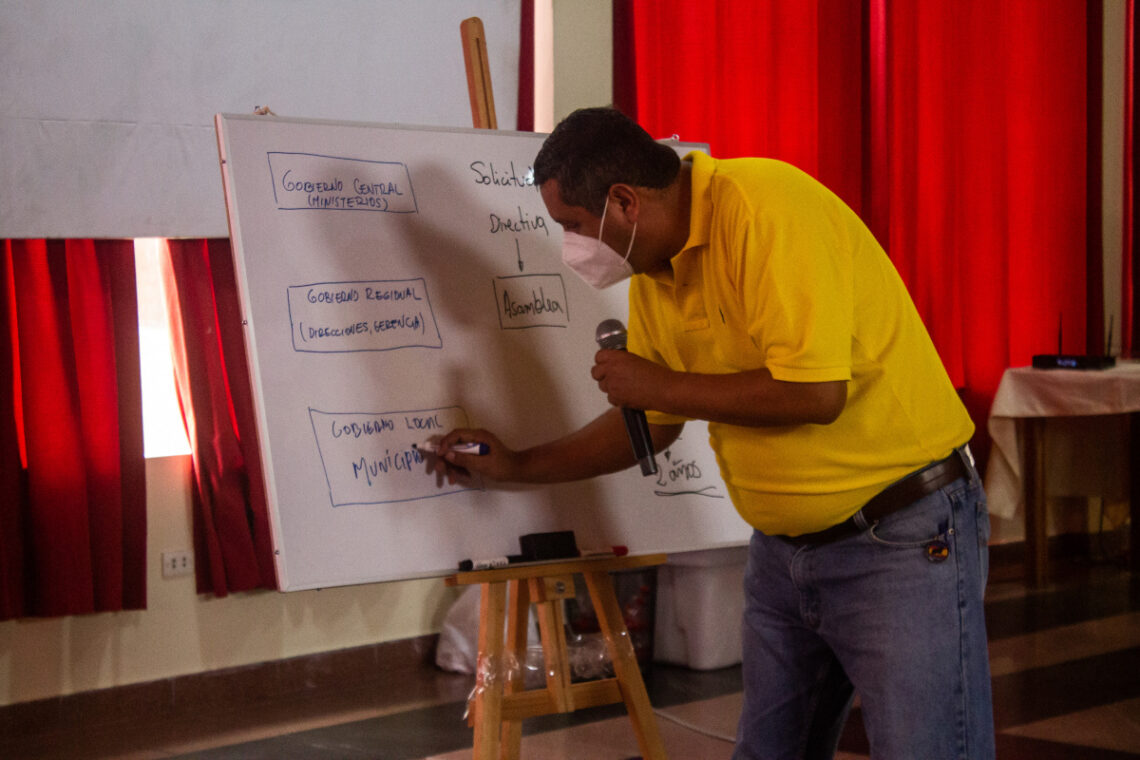
A representative from the Loreto Ministry of Culture explains the structure of Peruvian government.
The consequences of this lack of ability to interface with the Peruvian health and education agencies are severe. In the case of the health system, the impact can be measured in human lives. The health care provision to the Matsés communities is challenging and suffers from chronic and profound insufficiencies due to their remote geography and other contributing factors. In the morning, before we started the regular agenda, a team from the Ministry of Health met with the Matsés responding to an invitation from Daniel Vela, the Matsés chief. This meeting led to doctor and dentist visits to the larger Matsés communities and a resupply of medicines. In addition, we now have a Memorandum of Understanding between the Health Ministry, the Matsés, and Acaté. There will be more on this major development in a future field report.
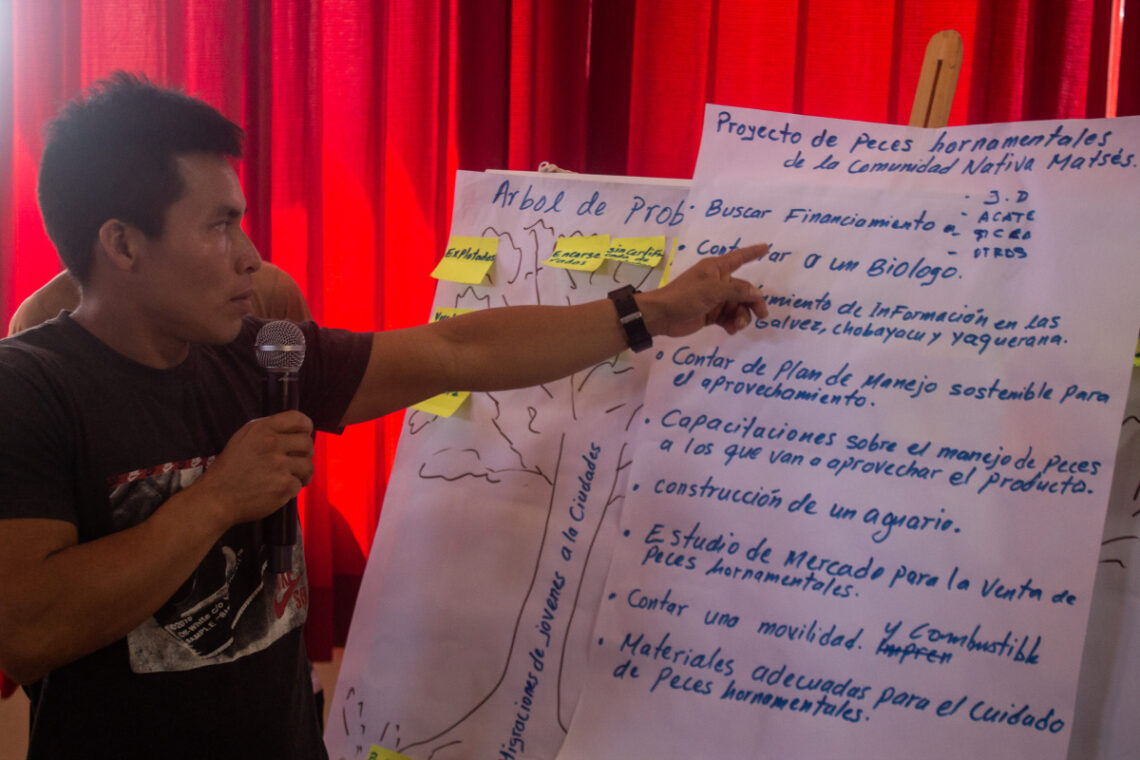
The Ministry of Culture also provided the team with the agencies that provide funding to communities for economic projects and detailed some of the existing projects. They then took the Matsés through an exercise of developing a project with all the steps and information required.
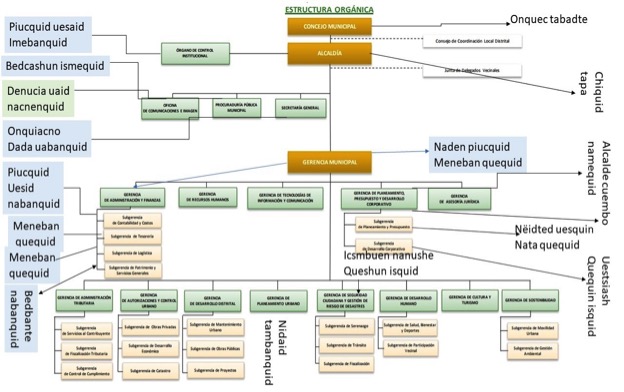
In the course of the session, the Matsés leaders developed for their reference an organizational flow chart of the intended structure and function of the local government with Matsés explanations
Peru is a country with a large bureaucracy that requires an almost unbelievable number of documents to accomplish even the most basic of tasks such as opening a bank account. Even minor errors in a document can lead to rejection of an application and starting the time-consuming process over again, often necessitating repayment of fees. The session finished with Acaté presenting the system for reporting sales and contract work to the Peruvian tax authorities. In Peru, organizations (including indigenous community organizations) are required to file taxes on a monthly basis. In addition, each receipt must be logged and submitted with a voucher. The tax authorities cross references each expense with the buyer and seller. If there is an error or omission it can result in heavy fines that carry exorbitant interest rates if not paid promptly. For low income individuals and indigenous communities these fees can be financially crippling. This reality amplifies the importance of proper accounting.
Accountability and Transparency
The session on the government transparency portal became very heated once the amounts of funds allocated from the national government to the regional district government were projected on screen in front of the assembled Matsés leaders. The local government is notorious for using Matsés who join their administrations as scapegoats to cover for their embezzlement of funds. They pressure the Matsés into signing documents that they did not understand. This caused four Matsés to be charged with embezzlement and at least one to serve prison time.

Pepe Fasabi, who is both a former Matsés chief and a former regional Mayor, outlines the structure of the regional government.
The Matsés had been told that the regional government had to largely shut down due to a lack of funding in early 2020. Seeing the records of considerable sums transferred by the federal government projected in front of them caused a furious reaction. This led to numerous phone calls and an unexpected appearance by the local Mayor and his staff. At the meeting the Mayor claimed that he would justify the discrepancies at a later meeting and that once the Matsés heard his explanations all would be settled. Of course, although the meeting was set-up and attended by the Matsés, neither the Mayor nor any of his representatives showed up.

The Matsés are now fully aware of the situation and there is an ongoing investigation by the anti corruption prosecutors.
Land Tenure and Rights
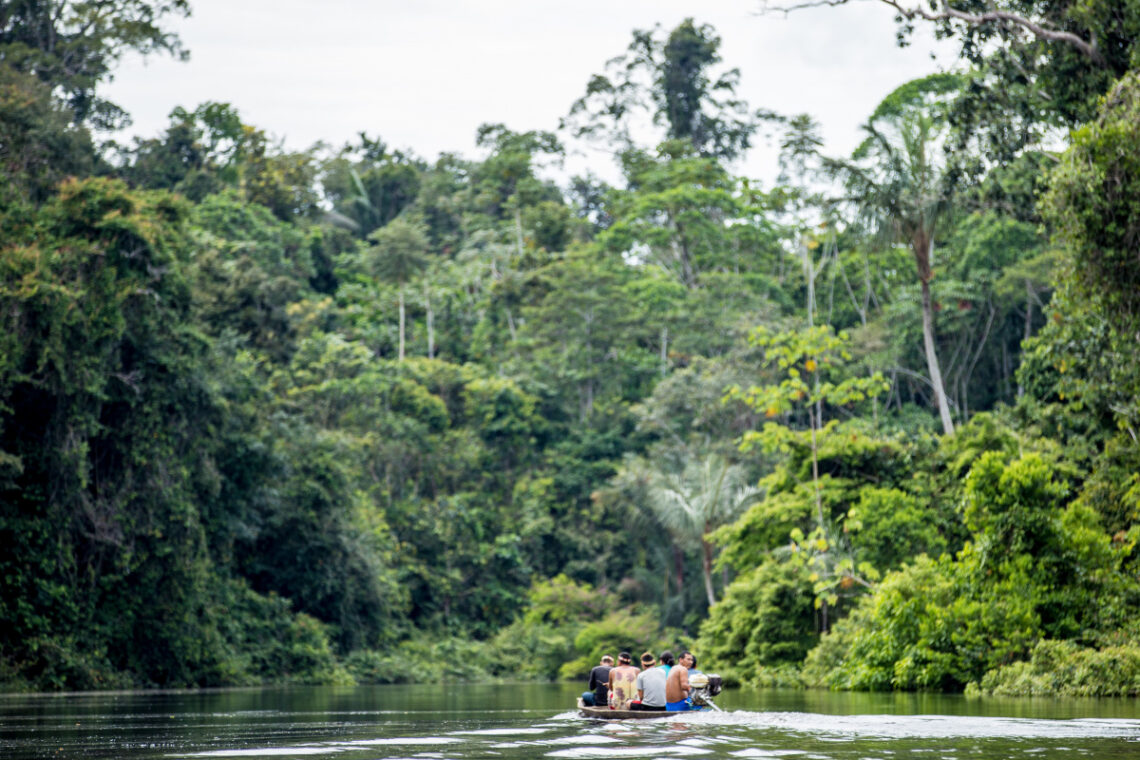
The next part of the meeting was to address the land tenure of the Matsés Ancestral Territory which spans their communal reserve, the Matsés National Reserve, and the Sierra del Divisor National Park. When the Matsés mapped their ancestral territory in the Matsés Indigenous Mapping Initiative, it became clear that many Matsés had no idea that a large portion of their territory had been negotiated away in the creation of the so-called Matsés National Reserve (Matsés ancestral territory in which the Matsés hold no title to the land) and the Sierra del Divisor National Park.
We brought in a local expert who worked on many projects in the region. The leaders were given a presentation on the rights and obligations of the Matsés titled land along with the applicable land codes under Peruvian law. Then the same was done for the National Reserve, which is the equivalent to a National Forest in the US, and the National Park. The event also included timber regulations. The most controversial aspect was the buffer zones established by the park authorities. We presented the regulations and, as this was very important, wrote a summary in the Matsés language.

Timber and Forestry Regulation
The Matsés leaders set up a meeting with OSINFOR (timber law enforcement agency) during the workshop to remediate a problematic situation with a timber company. In the Peruvian Amazon, timber companies are often closely tied to the narcotrafficking mafia so they are practically untouchable legally. Prosecutors who look too closely are intimidated with threats of violence. The timber mafia’s scheme is to get a Plan of Management approved from the Department of Agriculture for legal timber extraction in one community (such as from the Matsés) and then use that timber allowance under that plan to illegally cut down trees from another region which has more accessible timber but where logging is not legally permitted. Since the indigenous community holds the land title, when irregularities are found, the resultant fines are levied against the community and not the timber company itself. We brought in a Peruvian environmental law expert to answer the Matsés questions and help support them. The Matsés were able to take back control of their account from the timber company and documents for commercial activities using the new electronic portal. This will be reported in future field report.
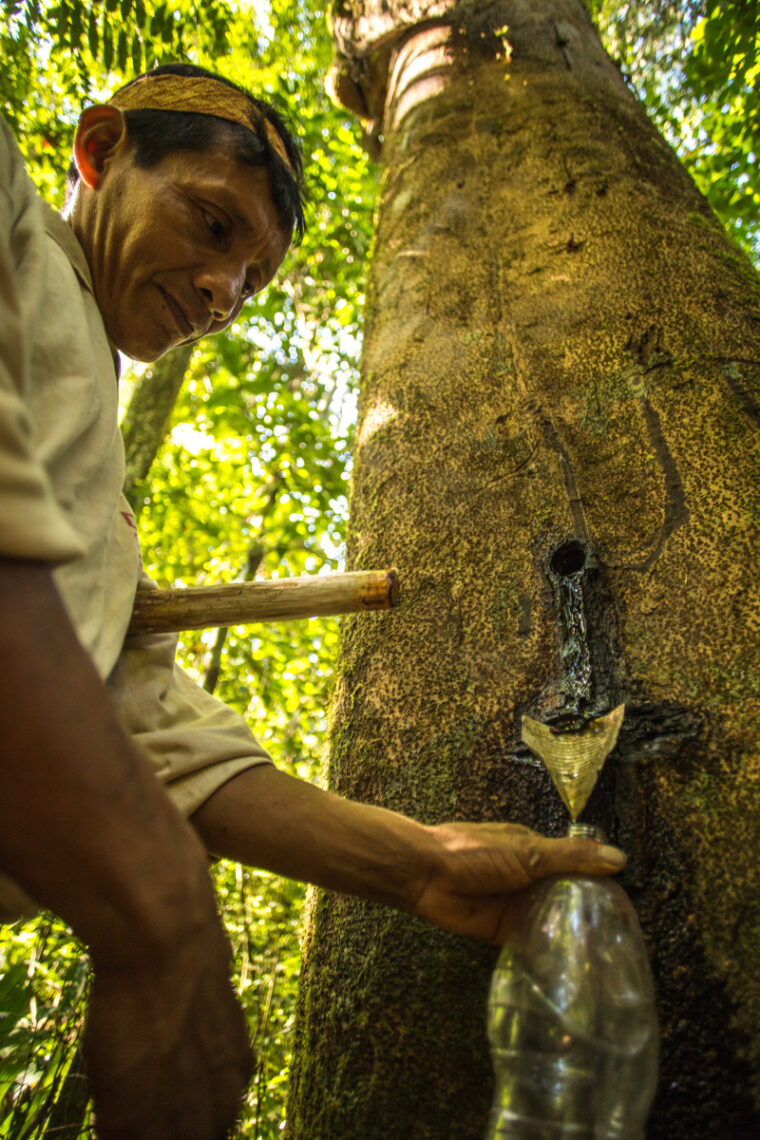
Acaté has partnered with the Matsés to create non-timber economic activities where few had existed, including developing approaches for the sustainable harvest of valuable copaiba resin, highly prized for its medicinal properties and as a base in cosmetics. This tree has been cut down in most areas of the Amazon for its hardwood, but in the Matsés Ancestral Territory trees can be found.
Translation of Matsés Bylaws into Matsés Language
Throughout the conference we were working to update and translate the Matsés bylaws, developed on establishment of the Matsés Communal Reserve. The bylaws were written in Spanish and all were very reasonable. The problem was that they were out of date and not available in Matsés language, which is the primary language for most Matsés. The challenge with translating Spanish technical terms into Matsés is that there are simply no equivalent words in Matsés language. Through the efforts of Matsés native speakers, Peruvian lawyers, and Acaté field coordinator Dr. David Fleck who is the leading academic expert on Panoan languages, we decided that we would make the best translation possible and then supplement the document with explanations in Matsés. Given that so many updates were required, the leaders could not complete the updates without first getting the consent of the people. The final document was delayed until the village meeting and a general assembly were held to finalize the document.
Leadership

Carla Noain of Acaté working with Matsés on the leadership training sessions
With so many difficult and controversial subjects that arose, we planned to finish the conference on a positive note with the creative leadership component. The leadership training portion of the program was led by Acaté staff member Carla Noain who was certified during a New England Biolabs Foundation course run by The Creative Action Institute in Peru. This groundbreaking course for indigenous leaders and youth promotes creative problem solving. While creativity is often perceived as an abstract concept, numerous studies and reports indicate that creativity is becoming a key feature of 21st century leadership due to the need to generate innovative solutions, test new approaches, and respond effectively to the complex social and environmental challenges we face.
Although not commonly referred to in the context of indigenous communities in the remote Amazon, there are creative leaders in the Matsés community and through this program we helped to develop their potential growth to lead their communities. One of the creative techniques is called “Problem Tree/Solution Tree”. A large drawing of a “Problem Tree” is used to analyze the causes and effects of a specific problem in order to identify strategic interventions. The problem is written in the center of the trunk, the participants then exchange ideas and write down all the underlying causes in the roots of the tree and all the negative impacts on the branches. Next, a “Tree of Solutions” is used to identify how to transform the problems by reversing the original causes and to track the conditions that yield positive results. The objective is to visually analyze the origins and effects of a problem in order to identify possible solutions and strategic interventions. The result is the ability to identify the origins of a problem and transform them into solutions through strategic analysis, identification of intervention points, and project planning.
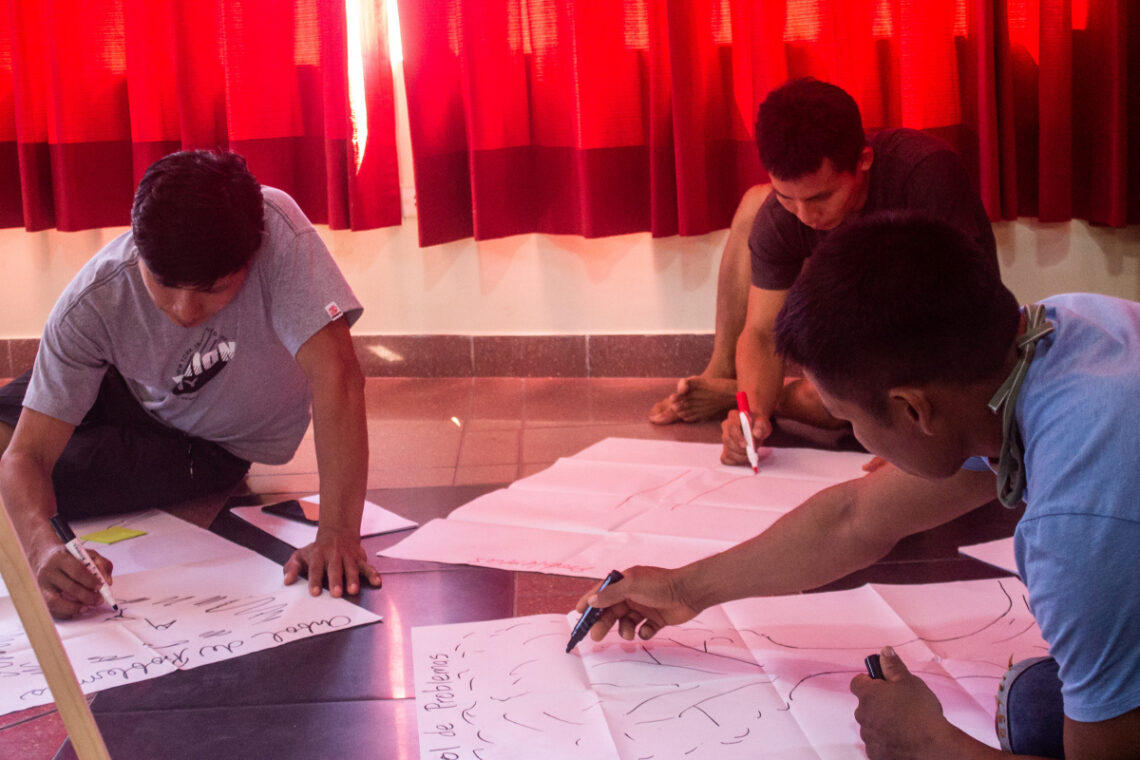
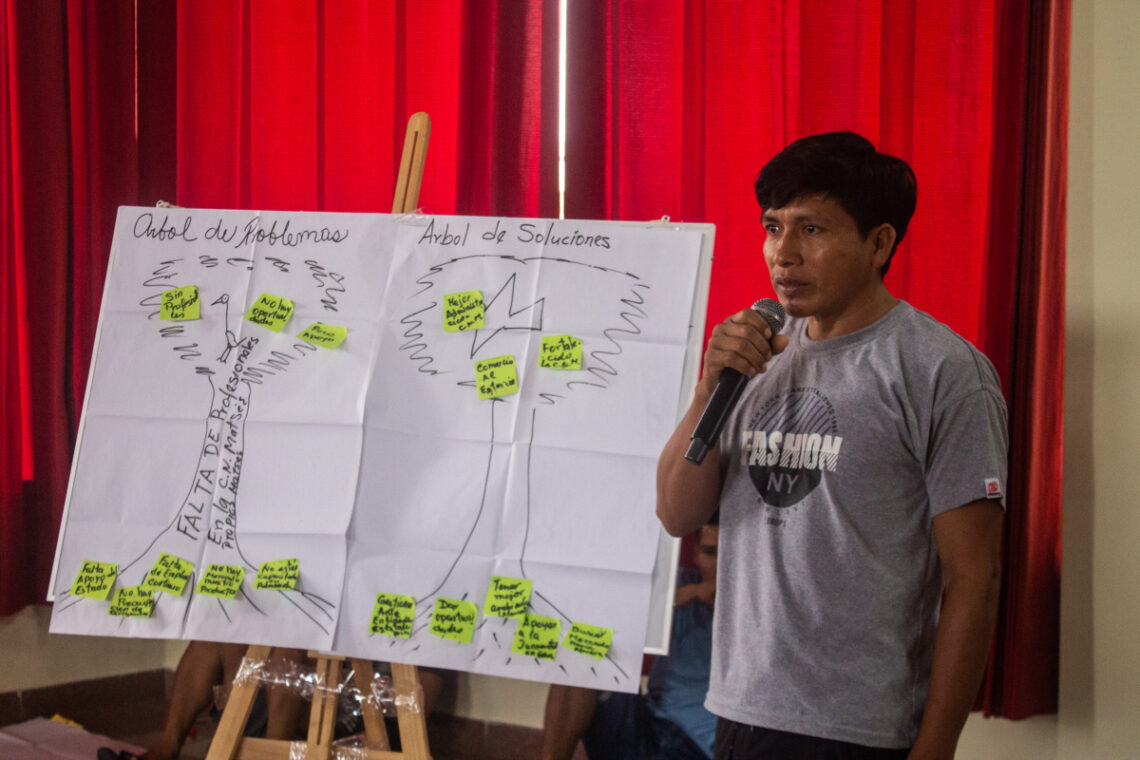
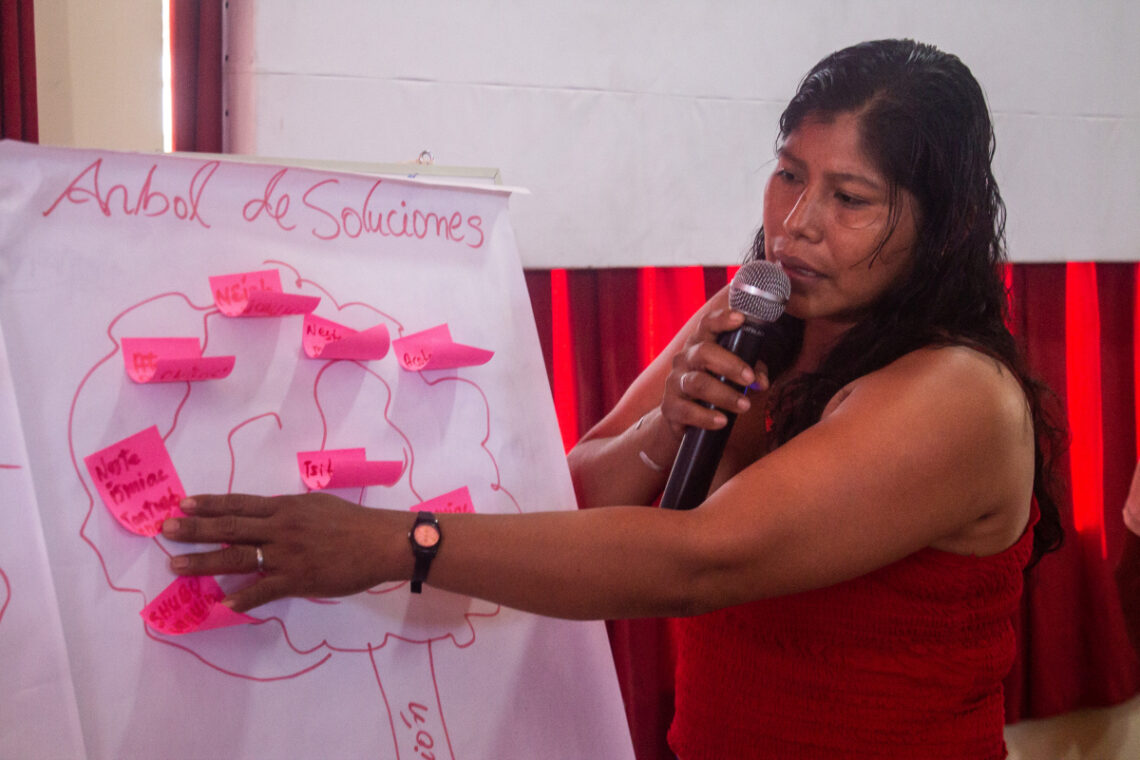

Stage 2: Village Meetings to Disseminate the Information from Stage 1 and Community Engagement

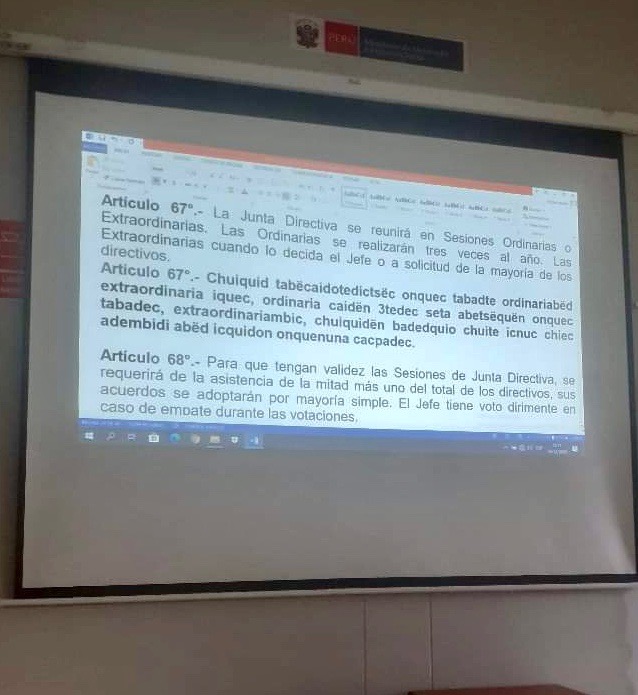
In the second stage of the Matsés Governance and Leadership Initiative, Matsés leaders went community to community presenting, informing and explaining the translated bylaws to all the Matsés.
After Stage 1 was completed we worked with the Matsés chief to compile all the information in digital and print form. Then a team of Matsés leaders and their main advisor, Pepe Fasabi, visited each of the 15 Matsés communities. Pepe was essential to this project because his experience and background. As both former Matsés chief and a former local Mayor, Pepe could speak with authority after having experience dealing with all these issues. We can only imagine how difficult it was in the past for the Matsés village leaders to report on material they were not very familiar with written in, what is for them a second language. With a projector and all the documents in digital form supported by the tribal leaders the village chiefs were able to inform their villages of all that had been learned. Each village was also given copies of the documents, explanations, and translation in print. It was during this phase that the final bylaws were prepared for ratification at the general assembly. The local meetings also generated a lot of anger and controversy as light was shed on the outrageous corruption of the local government.
Stage 3: Computer Training for Future Matsés Leaders

Matsés computer class students and instructors
Nowhere is the “digital divide” more stark than in Matsés territory. Most young Matsés, except for those who go to school in Angamos, have never used a computer. In Matsés territory, some leaders and teachers have computers but there are none in the schools or available for people to use. The irony is that we have never encountered people who pick up computers and software faster than the Matsés. In the Stage 3 of the initiative, the Matsés set up a computer lab with 12 computers, projector and printer in the community of Anushi. Then they developed a plan to hold twelve week-long courses for all the Matsés communities with spaces apportioned according to village size. Prior to the start of the classes we held a training session in Iquitos for the Matsés computer teachers, Daniel Vela, Jesinia Fasabi, and Felipe Bai. They developed an appropriate course curriculum for Matsés with little to no computer experience. The course started with basic usage and the operating system. Then the course progressed through Word, Powerpoint, and Excel. For many Matsés who have never used a computer their lack of experience is a source of shame. As soon as Matsés start to gain confidence in their computer skills their perceived inferiority to outsiders fades. They realize that they can use a computer but an outsider could never thrive in the forest. In total, to date, we trained 144 Matsés students.
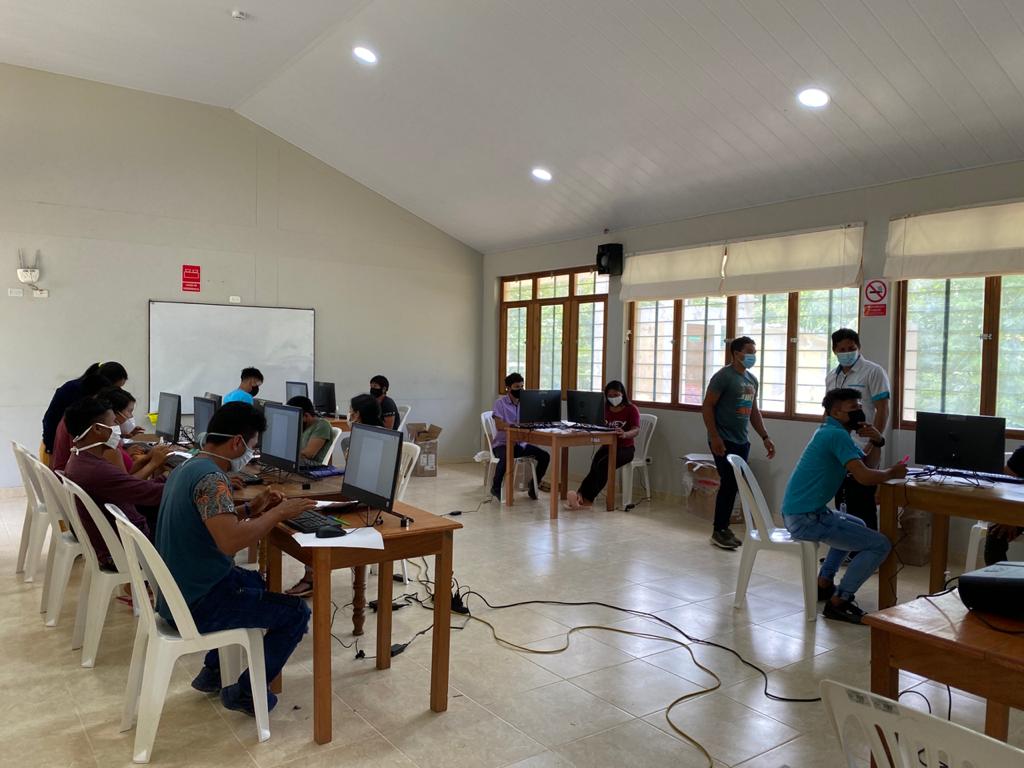
First computer lab developed in the Matsés Territory, part of the third stage of the Matsés Indigenous Leadership and Governance Initiative. The lab was set-up in a recently constructed civic building.
Prior to this initiative, both a lack of computers and the lack of training in document preparation among the Matsés population limits the number of potential leaders who can function in their roles. Capacitation in these domains will strengthen the ability of the Matsés to represent themselves to the outside world, navigate the bureaucracies of government agencies, participate in the national economy, and enhance coordination of their communities to foster strength in unity. Through this initiative, the Matsés will be better able to resist the powerful external forces that threaten the environment they depend on for their survival and sustain their unique way of life. The initiative will engage younger generations by inspiring youth that their identity as Matsés can lie in both traditional and modern systems, and that to choose one is an artificial choice; one can thrive in the outside world, yet retain a proud identity as Matsés.
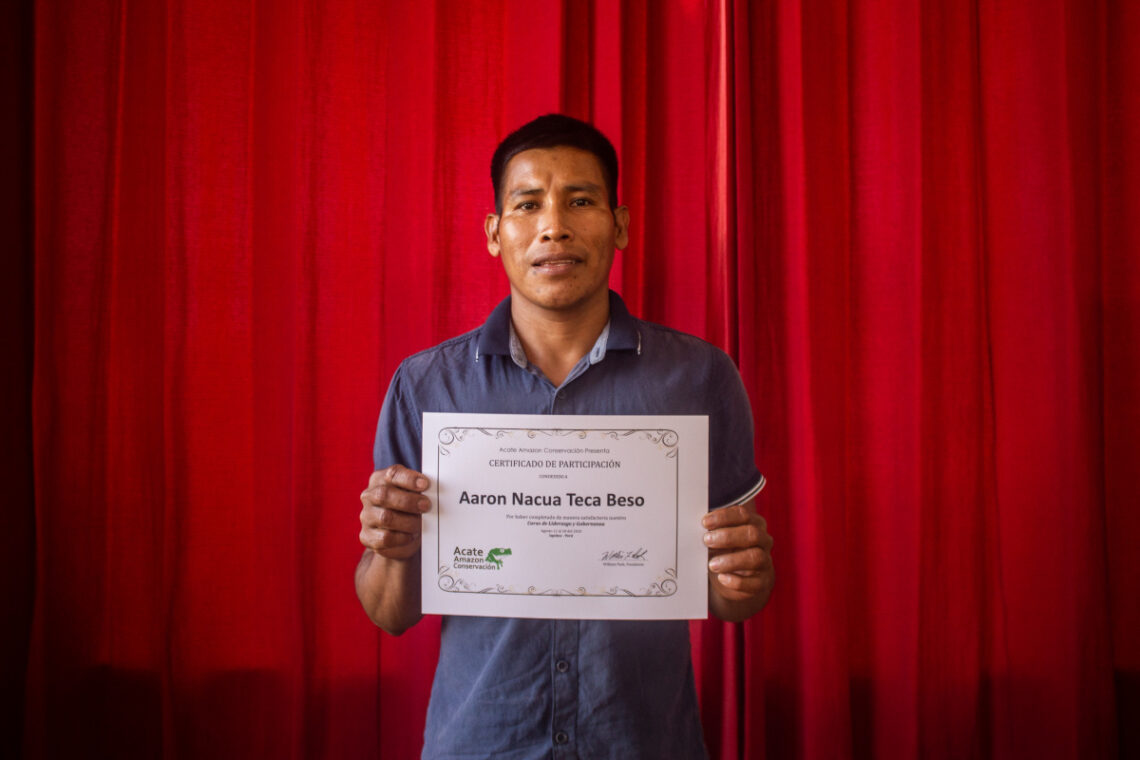
Portraits of some of Matsés who completed the Leadership and Governance workshops. Photographer Luis Adolpho. All images ©Acaté

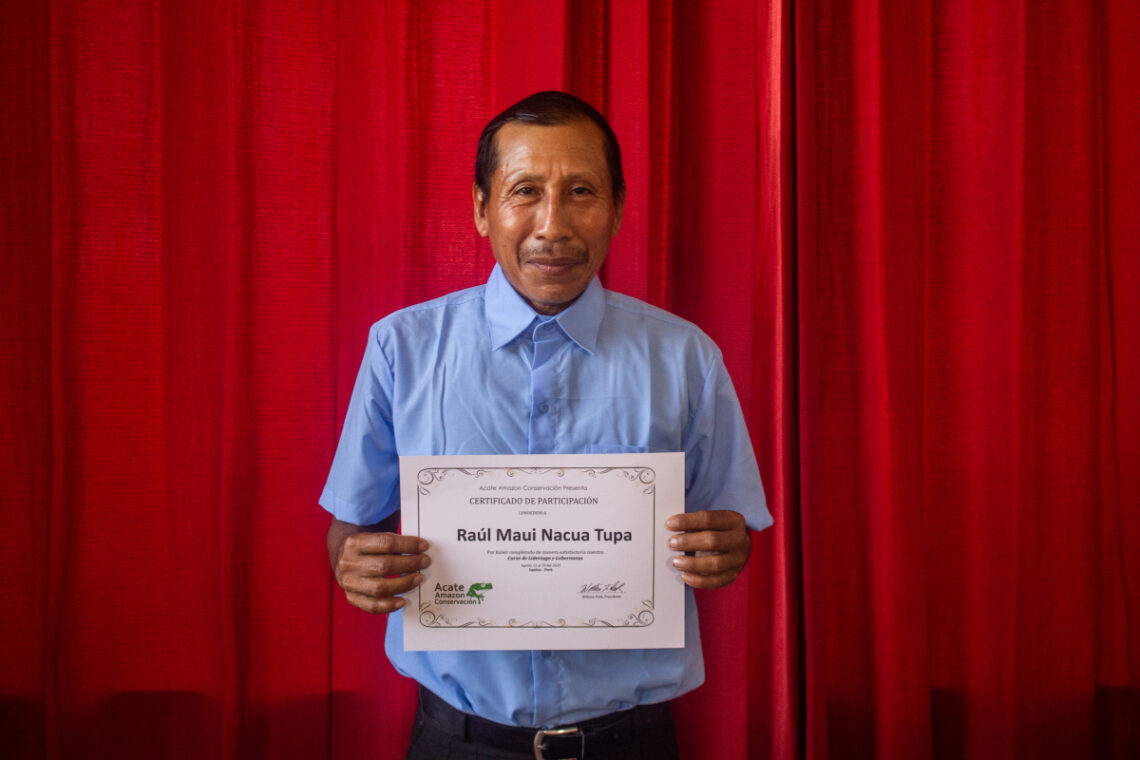
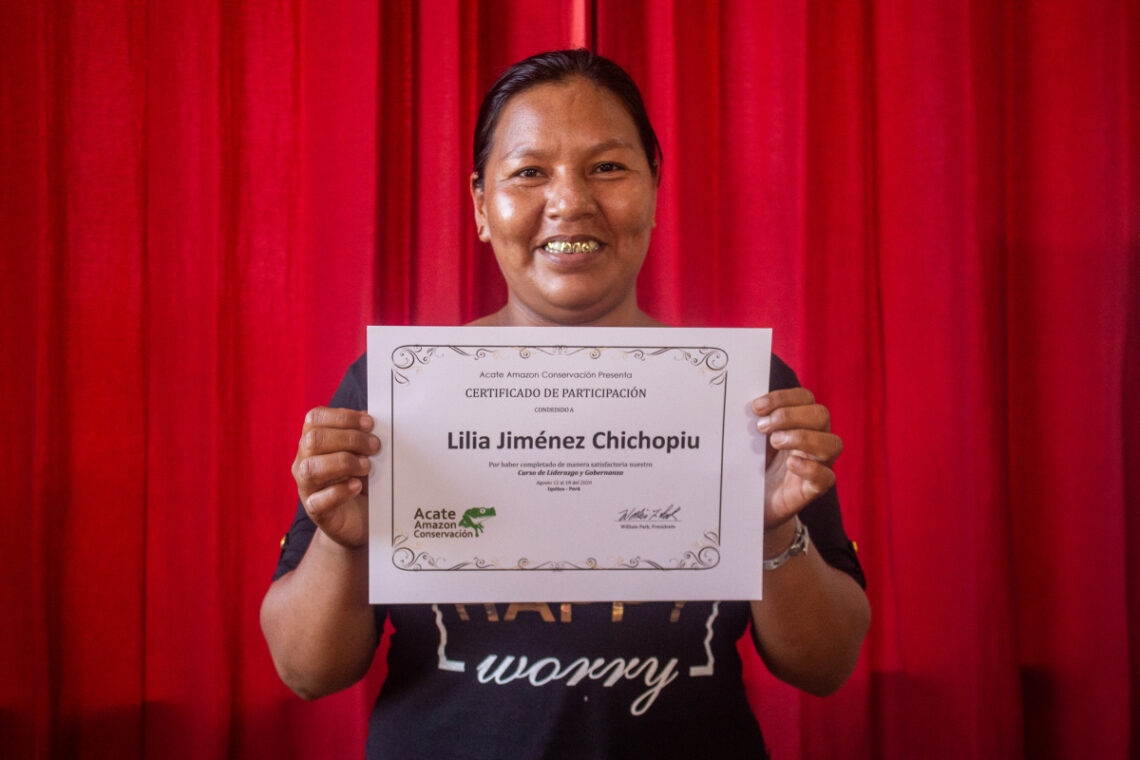
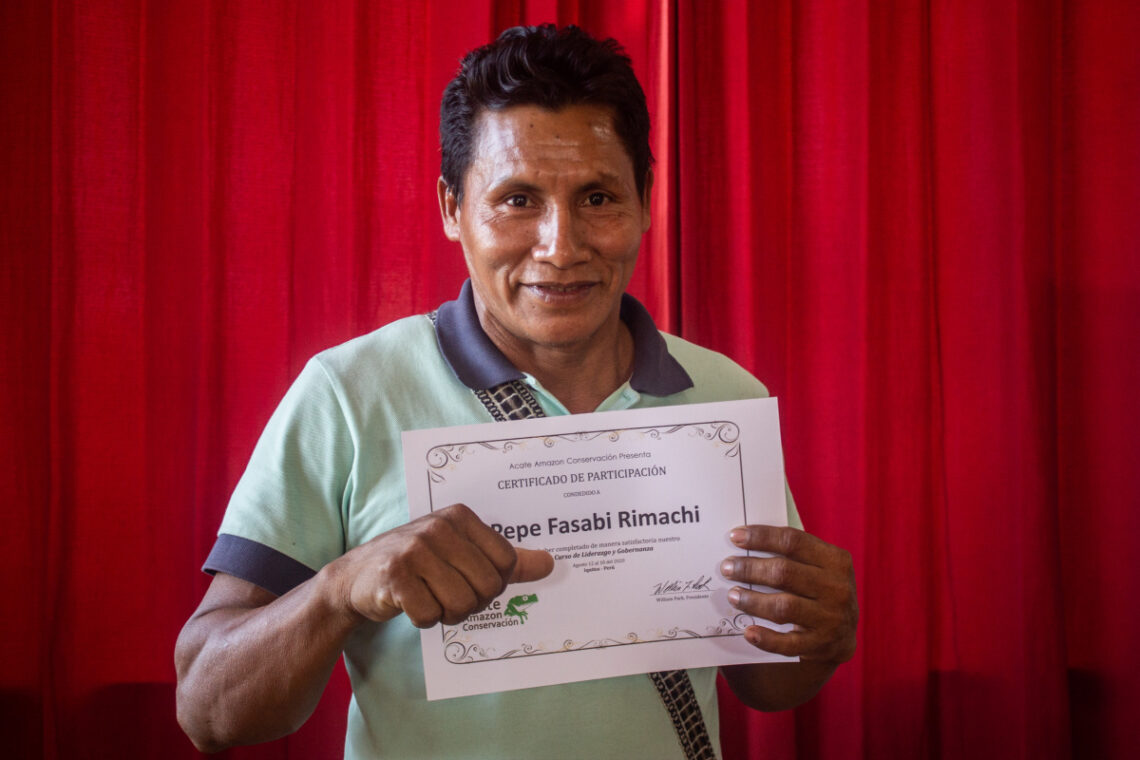

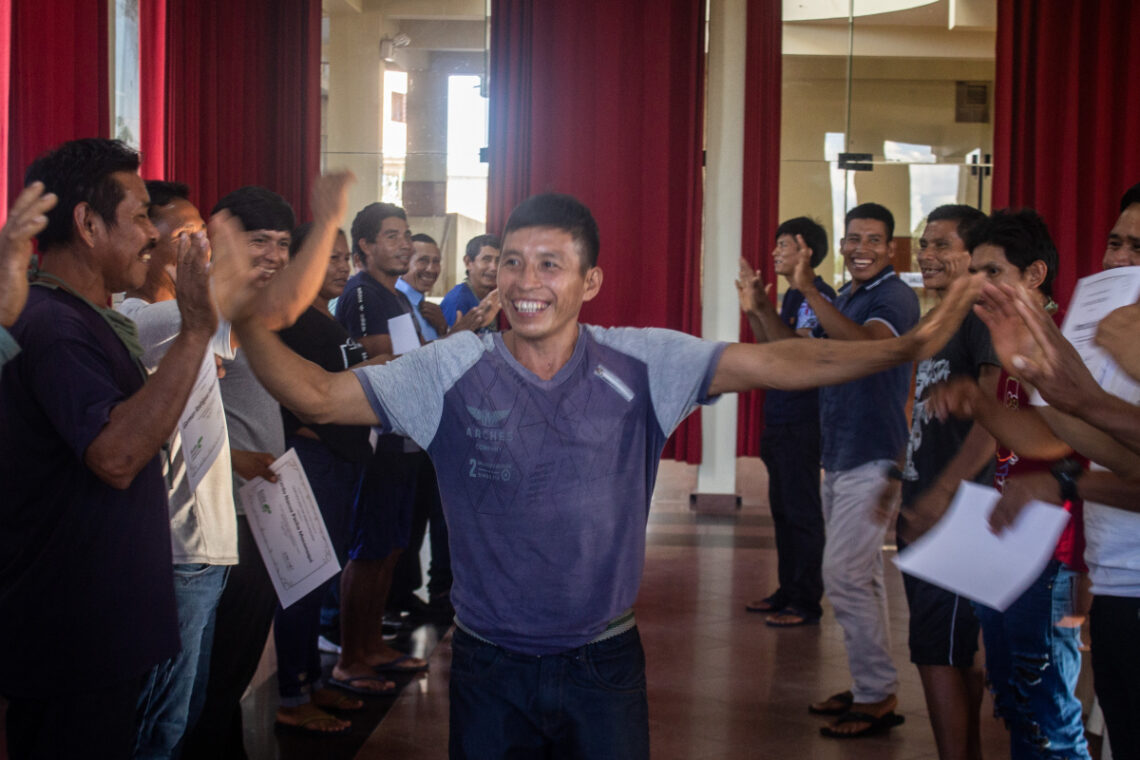
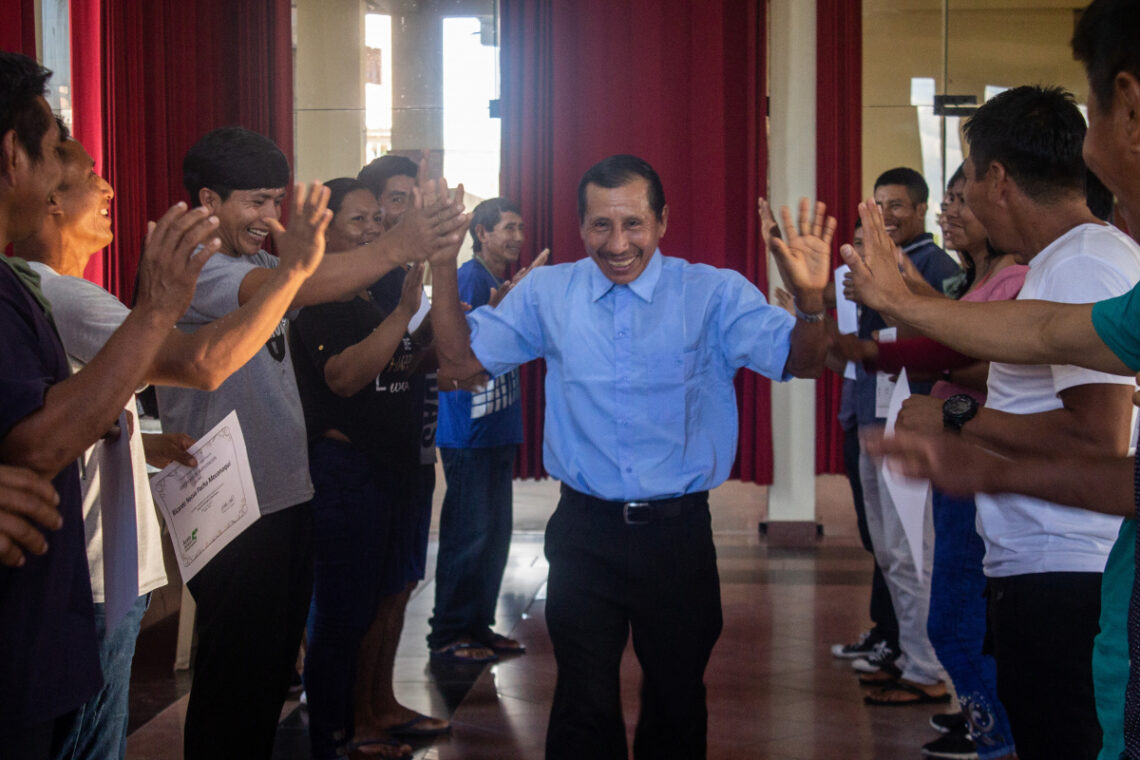
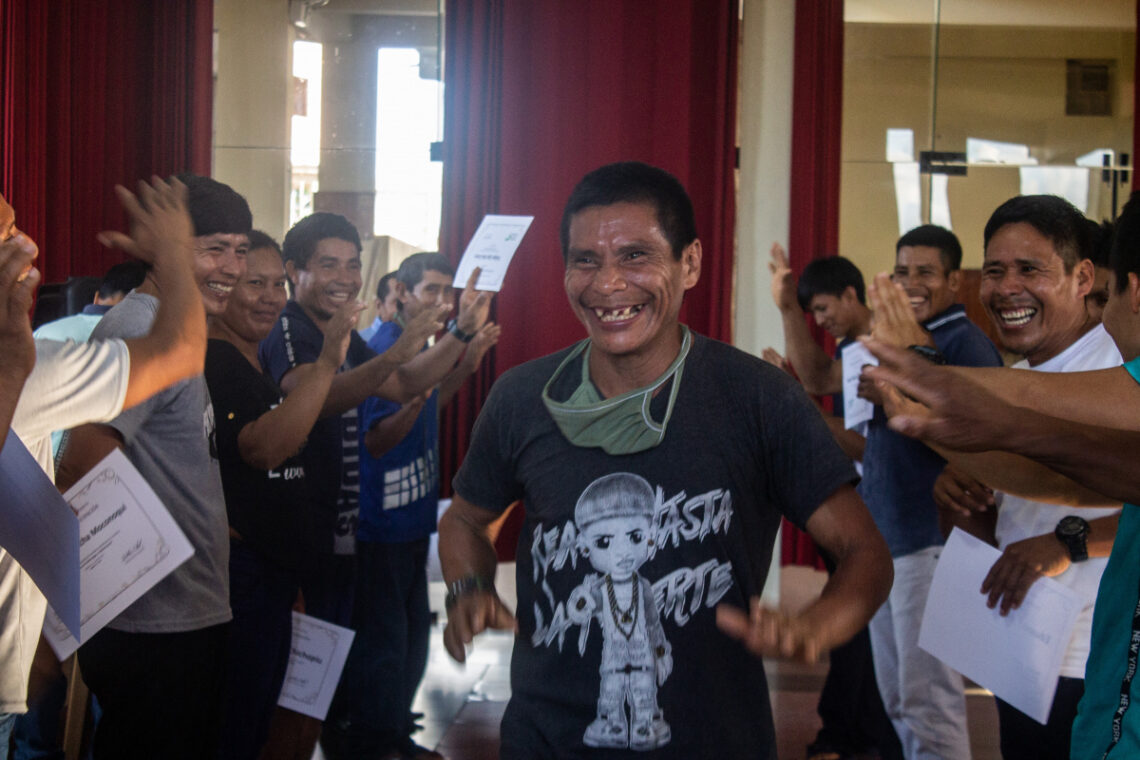
The Matsés Leadership and Governance Initiative was made possible through funding from the Irwin Andrew Porter Foundation, El Programa de Pequeñas Donaciones del Fondo para el Medio Ambiente Mundial, Global Green Grants and SERVINDI. We are grateful for their support.
Acaté Amazon Conservation TEST 10/14 is a non-profit organization based in the United States and Perú that operates in a true and transparent partnership with the Matsés people of the Peruvian Amazon to maintain their self-sufficiency and way of life. The Matsés safeguard a critical conservation corridor and shield some of the last remaining uncontacted tribes in isolation from unwanted encroachment from the outside world. Acaté works to protect their forests and way of life through supporting on-the-ground initiatives that are led by the Matsés indigenous people.
Operating on the frontlines of conservation, Acaté’s initiatives have included the first indigenous medicine encyclopedia as well as projects with original methodology in sustainable economic development, traditional medicine, medicinal agroforestry, nutritional diversity, regenerative agriculture, biodiversity inventory, education, native language literacy, participatory mapping, and protection of uncontacted tribal groups in isolation. All of our initiatives are developed with, led and implemented by the Matsés indigenous people. Donations are tax-deductible and go directly to fund these on-the-ground initiatives that operate with unparalleled transparency.
Recent Field Reports
November 2020 – New measures to help ensure continued protection of uncontacted tribal peoples in isolation
July 2020 – Emergency COVID-19 relief efforts and safe return of the Matsés to their communities!
June 2020 – Completion of the first-ever dictionary phone app created for an Amazonian indigenous language and more from our ongoing initiative with the Matsés to support bilingual education and intergeneration transfer of ecological knowledge.
December 2019 – Completion of the landmark five-year Matsés Indigenous Mapping Initiative in which the Matsés mapped and demarcated for the first time their entire ancestral territories in Peru. The resulting maps, written in their language, are comprehensive cartographic records of their ancestral territory, history, land use and culture.
July 2019 – Interview profiling our partner initiative with Xapiri that is generating much need economic opportunities for Matsés elders and youth and transmitting their artistic practices.
October 2018 – Completion of eight reader books, illustrated and written by Matsés authors based on narratives provided by Matsés elders. More than doubling the amount of native language books available for Matsés children, each book is designed to support native language literacy and pass down traditional rainforest knowledge.
All content copyright 2021 Acaté. Images copyright 2021 Acaté / Xapiri / Tui Anandi / Mike van Kruchten
